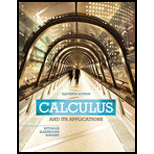Problem 1E: Graph. y=5x Problem 2E: Graph. y=4x Problem 3E: Graph. y=23x Problem 4E: Graph. y=34x Problem 5E: Graph.
5.
Problem 6E: Graph.
6.
Problem 7E Problem 8E Problem 9E Problem 10E: Graph. y=1.13(0.81)x Problem 11E: Differentiate. f(x)=ex Problem 12E: Differentiate.
12.
Problem 13E: Differentiate.
13.
Problem 14E: Differentiate. g(x)=e3x Problem 15E: Differentiate.
15.
Problem 16E: Differentiate.
16.
Problem 17E: Differentiate.
17.
Problem 18E: Differentiate. F(x)=e4x Problem 19E: Differentiate. g(x)=3e5x Problem 20E: Differentiate.
20.
Problem 21E: Differentiate.
21.
Problem 22E: Differentiate. f(x)=3ex Problem 23E: Differentiate.
23.
Problem 24E: Differentiate.
24.
Problem 25E: Differentiate.
25.
Problem 26E: Differentiate. g(x)=45ex3 Problem 27E: Differentiate. F(x)=4e2x Problem 28E: Differentiate.
28.
Problem 29E: Differentiate.
29.
Problem 30E: Differentiate. f(x)=x52e6x Problem 31E: Differentiate.
31.
Problem 32E: Differentiate.
32.
Problem 33E: Differentiate. F(x)=e2xx4 Problem 34E: Differentiate. g(x)=e3xx6 Problem 35E: Differentiate. f(x)=(x22x+2)ex Problem 36E: Differentiate.
36.
Problem 37E: Differentiate.
37.
Problem 38E: Differentiate. f(x)=exx5 Problem 39E: Differentiate.
39.
Problem 40E: Differentiate.
40.
Problem 41E: Differentiate. f(x)=ex2/2 Problem 42E: Differentiate.
42.
Problem 43E: Differentiate. y=ex7 Problem 44E: Differentiate.
44.
Problem 45E: Differentiate.
45.
Problem 46E: Differentiate.
46.
Problem 47E: Differentiate. y=ex+x3xex Problem 48E Problem 49E: Differentiate. y=1e3x Problem 50E: Differentiate. y=1ex Problem 51E: Differentiate. y=1ekx Problem 52E: Differentiate. y=1emx Problem 53E: Differentiate. g(x)=(4x2+3x)ex27x Problem 54E: Differentiate.
54.
Problem 55E: Graph each function. Then determine any critical values, infection points, intervals over which the... Problem 56E: Graph each function. Then determine any critical values, infection points, intervals over which the... Problem 57E: Graph each function. Then determine any critical values, infection points, intervals over which the... Problem 58E: Graph each function. Then determine any critical values, infection points, intervals over which the... Problem 59E: Graph each function. Then determine any critical values, infection points, intervals over which the... Problem 60E: Graph each function. Then determine any critical values, infection points, intervals over which the... Problem 61E: Graph each function. Then determine any critical values, infection points, intervals over which the... Problem 62E: Graph each function. Then determine any critical values, infection points, intervals over which the... Problem 63E: Graph each function. Then determine any critical values, infection points, intervals over which the... Problem 64E: Graph each function. Then determine any critical values, infection points, intervals over which the... Problem 65E Problem 66E Problem 67E Problem 68E Problem 69E Problem 70E Problem 71E: a. 65-74. For each function given in Exercises 55-64, graph the function and its first and second... Problem 72E Problem 73E Problem 74E: a. 65-74. For each function given in Exercises 55-64, graph the function and its first and second... Problem 75E: Find the slope of the line tangent to the graph of f(x)=2e3x at the point (0,2). Problem 76E: Find the slope of the line tangent to the graph of f(x)=ex at the point (0,1). Problem 77E: 77. Find an equation of the line tangent to the graph of at the point.
Problem 78E: Find an equation of the line tangent to the graph of G(x)=ex at the point (0,1). Problem 79E: For each of Exercises 77 and 78, graph the function and the tangent line using a graphing... Problem 80E: For each of Exercises 77 and 78, graph the function and the tangent line using a graphing utility.... Problem 81E: 81. U.S. Travel Exports. U.S. travel exports (goods and services that international travelers buy... Problem 82E: Organic food. More Americans are buying organic fruit and vegetables and products made with organic... Problem 83E: 83. Marginal Cost. The total cost, in millions of dollars, for Cheevers, Inc., is given by
where... Problem 84E: Marginal cost. The total cost, in millions of dollars, for Marcotte Industries is given by... Problem 85E: 85. Marginal demand. At a price of x dollars, the demand, in thousands of units, for a certain... Problem 86E: 86. Marginal supply. At a price of x dollars, the supply function for the turntable in Exercise 85... Problem 87E: For Exercises 87-90, use the Tangent feature from the DRAW menu to find the rate of change in part... Problem 88E: For Exercises 87-90, use the Tangent feature from the DRAW menu to find the rate of change in part... Problem 89E: For Exercises 87-90, use the Tangent feature from the DRAW menu to find the rate of change in part... Problem 90E: For Exercises 87-90, use the Tangent feature from the DRAW menu to find the rate of change in part... Problem 91E: Medication concentration. The concentration C, in parts per million, of a medication in the body t... Problem 92E: 92. Ebbinghaus learning model. Suppose that you are given the task of learning 100% of knowledge.... Problem 93E: Differentiate. y=(e3x+1)5 Problem 94E Problem 95E Problem 96E: Differentiate.
96.
Problem 97E: Differentiate. f(x)=ex/2x1 Problem 98E: Differentiate. f(x)=xex1+x2 Problem 99E: Differentiate. f(x)=exexex+ex Problem 100E: Differentiate.
100.
Problem 101E: 101. Use the results from Exercises 85 and 86 to determine the equilibrium point (the point at which... Problem 102E: Exercises 102 and 103 each give an expression for e. Find the function values that are... Problem 103E Problem 104E Problem 105E: A student made the following error on test: ddxex=xex1. Identify the error and explain how to... Problem 106E Problem 107E Problem 108E Problem 109E: For each of the functions in Exercises 109 – 112, graph
109.
Problem 110E: For each of the functions in Exercises 109 – 112, graph
110.
Problem 111E: For each of the functions in Exercises 109 – 112, graph
111.
Problem 112E: For each of the functions in Exercises 109 – 112, graph
112.
Problem 113E: 113. Graph
Use the Table feature and very large values of x to confirm that e is approached as a... Problem 114E format_list_bulleted




